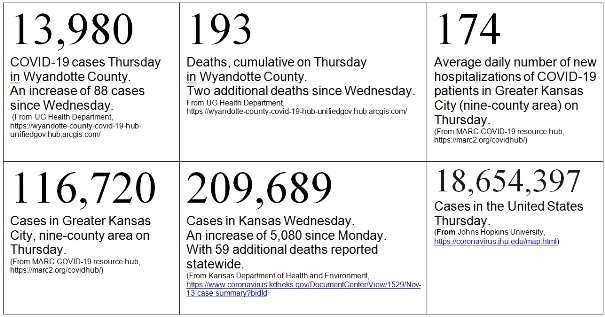
The University of Kansas Health System had given out COVID-19 vaccines to more than 400 health care workers by Dec. 23, according to doctors at the health system’s Dec. 23 news conference.
Their experience with the vaccine has been excellent so far, doctors said at the news conference.
After talking with other chief medical officers at Greater Kansas City hospitals, doctors estimated about 30 percent of the health care workers who had been offered the vaccine were turning it down at this time.
They are generally “vaccine-hesitant,” and some want to wait and see how others do with the vaccine.
The doctors said there could be side effects from the vaccine, and they might be worse after the second shot, but they are no worse than the side effects typically associated with the flu vaccine. The usual side effects can be pain at the site of the shot, a mild headache, a mild fever and tiredness or fatigue. In general, if people have any side effects from the vaccines, they have been tolerating them well, according to the doctors.
The second shot with the COVID-19 vaccine is necessary to reach the 95 percent protection level, according to the doctors. The protection will be shorter if people don’t return for the second shot.
Some other vaccine questions-and-answers written by the KU Health System and on the website:
Should I be concerned that development of the vaccine was rushed?
No. Vaccine development has been led by the world’s best scientists. One reason this came about so quickly is because the mRNA approach to creating a vaccine is highly precise. With new techniques, this sequence was developed in a matter of days. Stage 3 clinical trials testing the vaccines on tens of thousands of people have occurred. These all provide confidence in the safety and effectiveness of the vaccine.
Does the vaccine contain a live virus?
No. The COVID-19 vaccine does not contain a live virus.
Does the vaccine prevent spread of the disease?
This hasn’t been fully studied. We hope that it will, but the 2 vaccines coming out studied symptomatic COVID-19 cases. It’s possible that someone could have a mild or asymptomatic case of COVID-19 and be able to spread disease. It’s why the pillars of infection control (including wearing masks and distancing) remain important even after getting the vaccine.
Which is stronger, immunity after vaccination or immunity after recovering from COVID-19?
We believe the body’s immune response to the vaccine is stronger than it is to COVID-19 itself, especially if illness was mild. Trials have shown higher antibody concentrations that lasted longer in the trial patient groups than in people who recovered from COVID-19 after experiencing mild or no symptoms.
When will everyone who wants a COVID-19 vaccine be able to get one?
There are 20 million doses available now. Beginning in January, 5 million doses a week are anticipated to become available. It may be the middle of 2021 before the general public has full access to COVID-19 vaccines.
When will healthy seniors who don’t live in long-term care facilities be able to receive the vaccine?
We don’t yet know these exact details. Distribution is a matter of supply and demand. Today, we do not have the supply to fully meet the demand. This is why national, state and county health departments are working on phased distribution plans that target the highest risk populations first. As supplies increase, we will together be able to meet greater demand.
Will the vaccine protect us from this mutant strain of COVID we’re hearing about?
There isn’t enough data yet to be certain, but we expect the vaccines will offer protection against this mutation. Viruses actually mutate quite frequently. We expect them to. The medical community has been looking at these variations under the microscope since the pandemic began. The fundamental properties of the spike protein we talk about have not changed, so we expect the vaccine to remain effective.
More vaccine question-and-answers are online at https://www.kansashealthsystem.com/news-room/blog/2020/12/covid-19-vaccine-faq.
Case numbers reported
Wyandotte County reported an increase of 88 COVID-19 cases on Thursday, Dec. 24, according to the Unified Government’s COVID-19 webpage. There were a cumulative 13,980 cases. There were two additional deaths reported, for a cumulative total of 193.
The Mid-America Regional Council’s Kansas City Region COVID-19 Data Hub reported 116,720 COVID-19 cases on Dec. 24, with a total of 1,402 deaths in the nine-county regional area. There were 16 additional deaths Thursday. The daily average of new hospitalizations was 174.
Johns Hopkins University COVID-19 dashboard on Thursday reported 18,654,397 cases in the United States, with 329,097 deaths.
COVID-19 testing through the UG Health Department is not scheduled on Christmas, Dec. 25.
Testing sites are at https://wyandotte-county-covid-19-hub-unifiedgov.hub.arcgis.com/pages/what-to-do-if-you-think-you-have-covid-19.
For more test sites, also see https://www.gogettested.com/kansas.
For more information about the testing site at the former Kmart location, visit https://alpha.wycokck.org/files/assets/public/health/documents/covid/10092020_newtestingsitewyco.pdf.
To see information about the UG giving vaccines to health care workers, visit https://wyandotteonline.com/ug-to-start-giving-covid-19-vaccines-to-health-department-and-ems-personnel-next-week/.
The KDHE vaccine report is at https://www.coronavirus.kdheks.gov/DocumentCenter/View/1677/Vaccine-Update-12-16-20.
Cards and letters of encouragement for caregivers at KU Health System may be sent to Share Joy, care of Patient Relations, 4000 Cambridge St., Mailstop 1021, Kansas City, Kansas, 66160. Emails can be sent to ShareJoy@kumc.edu.
Wyandotte County is under a mandatory mask and social distancing order. Also, the Wyandotte County health order with a limit of 10 persons to a gathering, and a closing time of 10 p.m. for restaurants and bars, with other new restrictions, is at https://alpha.wycokck.org/files/assets/public/health/documents/covid/11162020localhealthorderexecuted.pdf.
The UG COVID-19 webpage is at https://alpha.wycokck.org/Coronavirus-COVID-19-Information.
The KDHE’s COVID-19 webpage is at https://www.coronavirus.kdheks.gov/.
The KC Region COVID-19 Hub dashboard is at https://marc2.org/covidhub/.
The Wyandotte County page on the Johns Hopkins COVID-19 website is at https://bao.arcgis.com/covid-19/jhu/county/20209.html.
The CDC’s COVID-19 webpage is at https://www.cdc.gov/coronavirus/2019-nCoV/index.html.
